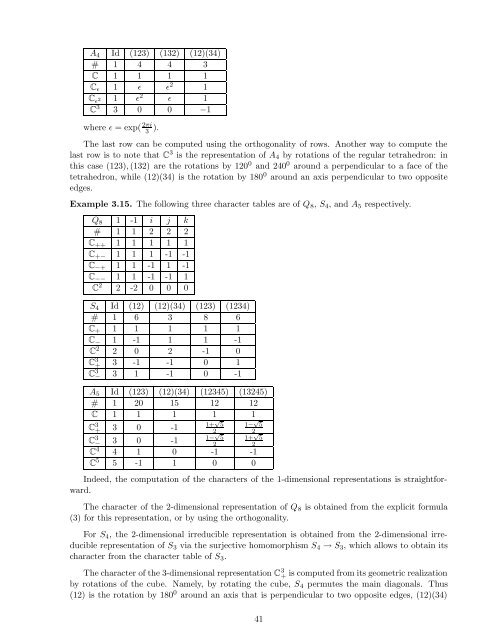Lecture notes for Introduction to Representation Theory
Lecture notes for Introduction to Representation Theory
Lecture notes for Introduction to Representation Theory
You also want an ePaper? Increase the reach of your titles
YUMPU automatically turns print PDFs into web optimized ePapers that Google loves.
A 4 Id (123) (132) (12)(34)<br />
# 1 4 4 3<br />
C 1 1 1 1<br />
C ρ 1 φ φ 2 1<br />
C ρ 2 1 φ 2 φ 1<br />
C 3 3 0 0 −1<br />
where φ = exp( 2 νi<br />
3<br />
).<br />
The last row can be computed using the orthogonality of rows. Another way <strong>to</strong> compute the<br />
last row is <strong>to</strong> note that C 3 is the representation of A 4 by rotations of the regular tetrahedron: in<br />
this case (123), (132) are the rotations by 120 0 and 240 0 around a perpendicular <strong>to</strong> a face of the<br />
tetrahedron, while (12)(34) is the rotation by 180 0 around an axis perpendicular <strong>to</strong> two opposite<br />
edges.<br />
Example 3.15. The following three character tables are of Q 8 , S 4 , and A 5 respectively.<br />
Q 8 1 -1 i j k<br />
# 1 1 2 2 2<br />
C ++ 1 1 1 1 1<br />
C +− 1 1 1 -1 -1<br />
C−+<br />
1 1 -1 1 -1<br />
C−−<br />
1 1 -1 -1 1<br />
C 2 2 -2 0 0 0<br />
S 4 Id (12) (12)(34) (123) (1234)<br />
# 1 6 3 8 6<br />
C + 1 1 1 1 1<br />
C−<br />
1 -1 1 1 -1<br />
C 2 2 0 2 -1 0<br />
C 3 + 3 -1 -1 0 1<br />
C 3 − 3 1 -1 0 -1<br />
A 5 Id (123) (12)(34) (12345) (13245)<br />
# 1 20 15 12 12<br />
C 1 1 1 1 1<br />
C 3 3 0 -1<br />
+<br />
1+ ⊗ 5<br />
1−2⊗<br />
5<br />
1− ⊗ 5<br />
1+2⊗<br />
5<br />
2<br />
C 3 − 3 0 -1<br />
2<br />
C 4 4 1 0 -1 -1<br />
C 5 5 -1 1 0 0<br />
Indeed, the computation of the characters of the 1-dimensional representations is straight<strong>for</strong>ward.<br />
The character of the 2-dimensional representation of Q 8 is obtained from the explicit <strong>for</strong>mula<br />
(3) <strong>for</strong> this representation, or by using the orthogonality.<br />
For S 4 , the 2-dimensional irreducible representation is obtained from the 2-dimensional irreducible<br />
representation of S 3 via the surjective homomorphism S 4 ⊃ S 3 , which allows <strong>to</strong> obtain its<br />
character from the character table of S 3 .<br />
The character of the 3-dimensional representation C 3 is computed from its geometric realization<br />
+<br />
by rotations of the cube. Namely, by rotating the cube, S 4 permutes the main diagonals. Thus<br />
(12) is the rotation by 180 0 around an axis that is perpendicular <strong>to</strong> two opposite edges, (12)(34)<br />
41

















